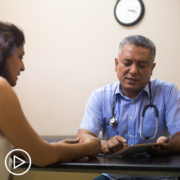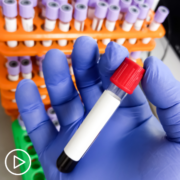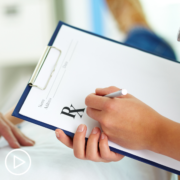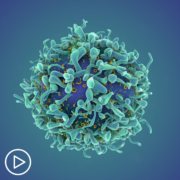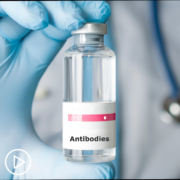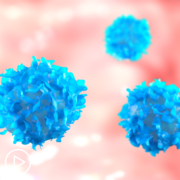In this START HERE myeloma program, Dr. Sikander Ailawadhi from Mayo Clinic spotlights priorities in the rapidly expanding myeloma treatment landscape. Watch as Dr. Ailawadhi addresses pressing questions submitted by patients and families, providing invaluable guidance and reassurance in navigating the complexities of myeloma care.
Download Guide | Descargar Guía
See More from START HERE Myeloma
Transcript:
Lisa Hatifield:
Hello and welcome. My name is Lisa Hatfield, your host for this Patient Empowerment Network START HERE program, where we bridge the expert and patient voice to enable you and me to feel comfortable asking questions of our healthcare teams. The world is complicated, but understanding your multiple myeloma doesn’t have to be. The goal is to create actionable pathways for getting the most out of myeloma treatment and survivorship.
Joining me today is Dr. Ailawadhi, back by popular demand. Dr. Ailawadhi is a respected multiple myeloma expert from Mayo Clinic. Dr. Ailawadhi’s career focus includes the treatment of plasma cell disorders like myeloma and understanding the epidemiology and pathophysiology of this disorder. It’s always such a pleasure having you, Dr. Ailawadhi. I’m really excited you’re joining us again. So thank you for joining us.
Dr. Sikander Ailawadhi:
And thanks a lot for having me, Lisa. This is excellent. I look forward to this next iteration of the Patient Empowerment Network START HERE program.
Lisa Hatfield:
Thank you. So before we dive into today’s discussion, please take a moment to download the program resource guide using the QR code. This guide contains pertinent information to guide you both before and after the program. And this program will provide you with a comprehensive update on the latest myeloma news and its implications for you and your family. Following that, we’ll launch into some questions that we have received from you.
So let’s start here. Dr. Ailawadhi, at this juncture in myeloma history, we are witnessing unprecedented activity, a surge of new treatment options, and a wealth of insights. Today, we are privileged to have your expertise to help us decipher these developments and shed light on the advancements shaping the landscape of myeloma care. First, we’re going to get a high-level update from Dr. Ailawadhi on what the latest myeloma news means for you and your family. And then we’re going to talk about some questions that you’ve sent in. So let’s get started with the high-level update, Dr. Ailawadhi. Can you speak to the latest news and priorities in the rapidly expanding myeloma treatment landscape?
Dr. Sikander Ailawadhi:
Excellent. I think, Lisa, that’s an excellent and important question. Because as you rightly mentioned, there is such a large amount of data that is coming through for myeloma all the time. I mean, it’s almost, we kind of talk about the fact that every time you turn your shoulder or look over your shoulder, there is a new drug approved. So I can imagine this can be very overwhelming. So what I’ll say is that in my opinion, there are some categories of new data that are pertinent and important for our patients.
The two or three out of them that come to my mind, one is what’s called CELMoDs, or there are a couple of agents there called iberdomide, mezigdomide. These are showing some interesting data. Important to keep in mind that they are somewhat related to the immunomodulatory drugs lenalidomide (Revlimid), pomalidomide (Pomalyst), but they’re showing benefit in patients who have had len and pom before and have progressed. So exciting stuff there.
We’re also seeing some interesting data about newer CAR Ts and bispecific antibodies. They are all coming up with some benefits in some cases. I think it’s important to keep in mind that the bispecifics are landing at the 60 to 70 percent response rate, and CAR Ts are typically landing at the 80 to 90 percent response rate, but there are more agents expected.
There are also some newer bispecifics in different classes, like one of them is called cevostamab, which is an FcRH5 inhibitor or targeting bispecific. So newer bispecific, not just more of the same category. And there has also been recent data about Bcl-2 inhibitors, which have been traditionally used for patients with translocation 11;14.
There have been some negative data, negative as in trials, which did not pan out with a drug called venetoclax (Venclexta), but there are two other drugs that had some recent data shown from different companies, which were exciting information. So in my mind, those are kind of the broad new drug categories. There is another, a couple of other quick things that I’ll mention.
One is we’re getting more and more information about real world experience with these new drugs. It’s good to see that CAR Ts are panning out very similar in the real world as they are in clinical trials. We’re also seeing that the side effect profile of a lot of these newer novel immunotherapy drugs is similar as seen in the clinical trials.
Racial ethnic disparities are something which are very close to my heart, and there is more and more information coming out in that. Unfortunately, highlighting the disparities more still rather than yet coming up with solutions. And I think the last thing that I feel which has been recent has been at the American Society of Hematology meeting in 2023, which was in December in San Diego.
One of the myeloma studies actually became a plenary session presentation, which is a pretty big deal for any disease area. So one thing is that it gets highlighted. Secondly, it was a combination of a regimen called isatuximab-irfc (Sarclisa) with carfilzomib (Kyprolis), lenalidomide, and dexamethasone (Decadron) in newly diagnosed patients.
It’s a randomized trial, Phase III, which was presented. I think the important part is we saw unprecedented deep responses and patients in much, much higher numbers than before becoming MRD-negative. So very deep responses. So these are kind of some very broad, but lots of highlights that I talked about.
Lisa Hatfield:
All right. Thank you. So can you also talk about some of the newer tools for myeloma progression and relapse and what patients might want to know about that? And in particular, maybe talk a bit about MRD testing and the role of MRD testing for patients who relapse.
Dr. Sikander Ailawadhi:
Excellent question. Lisa, I think the first and foremost thing an important part for our patients to learn is what are their “tumor markers,” for the, or disease markers for myeloma. We can follow myeloma by either the M spike or monoclonal protein, by light chains, by monoclonal protein in the urine or blood. And it’s important to keep that in mind because every now and then we’ll see patients who say, Hey, my ratio changed. So I’m progressing. Well, that comes after the light chains change. So it’s important to understand the role of these things.
So M spike in the urine, M spike in the serum and light chains. One of them is typically the marker for a patient. Now the MRD status or minimal residual disease that is looking for one cell, one myeloma cell from amongst 100,000 cells in the bone marrow. So it is looking at a very deep level. The most important benefit of MRD testing right now is to understand that if a patient turns MRD negative, then they have a superior outcome. Their prognosis is better. Their progression free survival, or the time before their disease comes back is longer.
But when a patient is MRD-negative and is being followed or maintenance or whatever, if the bone marrow turns MRD-positive, then that might be the sign that the disease might be coming back. Right now, we do not keep switching drugs to get to MRD-negative. That is not the goal of treatment. The way to think about it is we want to get to MRD-negative, but that means it’s incumbent upon us to try and pick a regimen that is more likely to get to MRD-negative. That’s the way to think about it.
Let’s pick a regimen more likely to get us into MRD-negative and hope that we get to MRD-negative. We see every now and then that the patients keep switching regimens just to get to MRD-negative. That’s not the way to go because you’re just using up options too quickly, too fast. A common question that patients ask is, well, does that mean I need to get annual bone marrow biopsies and MRD testing? Probably not.
That’s too much testing. So what I suggest is that once somebody has turned MRD-negative, it’s important to keep an eye on every single thing. Now, change in any of the routine labs, imaging, new symptoms, etcetera. That’s when we switch to the bone marrow again and see if the patient has turned MRD-positive. There are clinical trials going on right now which are stopping drugs based on repeat MRD negativity or starting drugs on MRD positivity. But those are clinical trial questions.
Lisa Hatfield:
Okay. Thank you for that. So along those same lines, since you’re a Mayo physician, I’m curious about the mass spec testing. So if a patient say has been MRD-negative for some time, still wants to monitor at a deeper level, even though it’s not commercialized yet, do you see a role for mass spec testing on a regular basis in the future and being rolled out to community facilities also?
Dr. Sikander Ailawadhi:
Absolutely, Lisa. I did not specifically bring it up because mass spec is not, like you rightly said, is not yet commercially available. Now we’re doing mass spec quite frequently at Mayo Clinic. Basically mass spec is taking up a blood sample. Important to keep in mind, it’s not a bone marrow test, it’s a blood test, but it looks for those abnormal proteins based on the protein weight at a much, much lower level. Our SPEP or serum protein electrophoresis does not pick up very small quantities of the protein mass spec does. So in an essence, the mass spec, if somebody is negative on that, turning mass spec negative to mass spec positive may be an earlier sign of the disease coming back rather than the SPEP yet turning positive. But as you rightly said, it is not yet commercially available. I do see the benefit of it.
There is more and more data coming in favor of it, and there was data that was also at ASH. So I do see that in the future we’ll be able to most likely have it available more widely. At this point, it is just a blood test to attempt to check the disease level at a much deeper level and be able to notice if the disease is progressing sooner than our currently available tools.
Lisa Hatfield:
Great. Thank you. And as a patient, I like to have one more data point that they can get from my blood, not from my bone marrow to assess the disease. So thank you for explaining that. Regarding survivorship, patients are living longer with myeloma in general because of the novel therapies that have come out in the past few years. So how is myeloma survivorship evolving, and what’s different now than it was five or 10 years ago in terms of treatment planning?
Dr. Sikander Ailawadhi:
Yeah, I think it’s very important to keep that in mind. When I see a newly diagnosed patient, I’m not just telling them, “Hey, this is your induction therapy, and your transplant is the goal.’ We’re trying our best to decide that patient’s life journey with myeloma over the next 10, 15 and hopefully more years. So we’re trying to pick and choose the regimen that is most likely going to help the patient the most today and most likely will give a longer duration of the response. So when you say survivorship, that also very importantly brings up the point that patients are living with myeloma longer. We have to manage their health overall. So looking for any side effects from treatment, managing them very well so the patient is able to stay on the treatment and maintain good quality of life.
There are actually, are clinical trials looking at stopping treatment when there is a very deep, prolonged response. Again, going towards survivorship and giving the patient’s quality of life. There is looking for other cancers. In fact, I had a patient in the clinic and we were talking about just myeloma in general and I was telling them, “Okay, please remember you may not want to do a colonoscopy, but you already have one myeloma cancer diagnosis. The risk of subsequent cancers is always there in any cancer patient.” So that was a male person. So I said, “Okay, please do not miss your colonoscopy. Please do not miss your prostate screening and whatever is age-appropriate must be done.” So managing everything because myeloma is not a sprint, it’s a marathon.
We want to make sure that we pace ourselves well so we manage all the symptoms, all the signs. Bone health becomes much, much more important because the same bone structure is now going to carry us longer and many more years. And as you rightly said, planning, which treatment comes first, which comes next, when does CAR T come? It’s not that everybody must get CAR T today. That’s not the answer. So what to use when becomes extremely more important.
Lisa Hatfield:
Thank you for that. And thank you, Dr. Ailawadhi, for that important reminder. All of you watching, get your regular screenings, like he said, prostate cancer, mammograms, colonoscopies, get it done. So thank you for that.
One of the things that comes up with that regular, not regular screening, but monitoring after certain therapies for future malignancies, there’s been some discussions about post-CAR T, particularly with T-cell malignancies and monitoring for that. Can you just give a little description of that and any concerns that you have with that or any encouragement you have regarding that and whether that weighs into your treatment options that you give to patients when they are asking about CAR T therapy?
Dr. Sikander Ailawadhi:
Absolutely. Extremely important question, Lisa. This really had a lot of discussion going on. It’s been going on for the past few months now. Okay. So first let’s explain the landscape. The FDA reviewed CAR T-cell treatment because of the fact that there were about 19 T-cell malignancies noted in several thousand patients.
Out of those 19 cases of T-cell malignancies, there was one case of multiple myeloma to the best of my knowledge. Now, risk of subsequent cancers is something, unfortunately, every cancer patient lives with, but in myeloma, we have known about that, especially from our historical knowledge of second malignancies with lenalidomide-based maintenance therapy post-transplant. So subsequent malignancies have always been a risk. There is some risk that is being talked about with CAR T, but frankly speaking, the way I look at it, the risk is significantly lesser than the potential benefit.
Because remember when these CAR T therapies, the two agents got approved in myeloma, they were approved in a situation that there was no standard therapy. And we saw somewhere about 70, 75 percent response rate with one of them and about 98 percent response rate with the other one. So in a setting where there was nothing, you can see the degree of benefit. And the risk of second malignancies is relatively small. So we must discuss this.
A patient must be aware of it, but I think the benefit is way more than the risk. So we document, we discuss, we have specific documentation that we do and specific information that we share with patients, but I think still the benefit is significantly more than the risk.
Lisa Hatfield:
Great. Thank you so much for explaining that. And for any of you out there watching this, Dr. Ailawadhi is a myeloma specialist, and I highly encourage anybody who is looking at CAR T therapy or even for a first consult for myeloma, seek out even one consult from a myeloma specialist. It is so important in trying to understand these therapies and any fears you may have regarding those therapies and the risks of that. So really appreciate that, Dr. Ailawadhi. Thank you. So I think it’s time now to start answering questions from patients that we received from all of you in the audience.
Please remember, this is not a substitute for medical care. Always consult with your medical team. And we are going to jump right in, Dr. Ailawadhi. We have a lot of questions from patients here and I’ll just start with the first one. This patient is asking, my M spike keeps rising in spite of chemo. What can I do?
Dr. Sikander Ailawadhi:
Very important question, Lisa. Every patient must understand what their disease marker is. This patient is asking about the M spike, which is the monoclonal spike, whether it’s in the blood or in the urine. And if the M spike is continuing to increase and there is a significant increase, significant is defined by at least 25 percent from the nadir or from the bottom most point with the, at least a absolute increase of 0.5 gram per deciliter. So half a gram per deciliter. So we want a 25 percent increase, but we also want at least 0.5 gram per deciliter.
So if somebody had an M spike of one at their best point, then the increase to 1.5 is significant. If somebody had the M spike of 0.2, then it’s not the 25 percent increase, it’s the 0.5 that must happen. So they hit 0.7 and that’s a significant increase. So that’s how we think about M spike, 25 percent with an absolute of at least 0.5 gram per deciliter.
If that is indeed happening, this would be considered a biochemical progression. And at that point, it should be considered to switch around the treatment because we don’t want the disease to grow to the point that there are actually symptoms showing up or organ damage happening. We want to be able to capture the disease progression sooner and act upon it.
Lisa Hatfield:
Great, thank you. Do you have any recommendations for people who, as we might have some patients watching this, who are light chain only? Any guidelines on if those numbers are rising?
Dr. Sikander Ailawadhi:
That’s an excellent question too. So if somebody has light chains as their marker, we are looking at an increase in the involved serum free light chain. So if somebody has kappa as their marker, the kappa is going up, or if they have lambda as the marker, the lambda is going up. Typically, if both of them go up, that is not disease progression. That could be coming from kidney dysfunction. Somebody is dehydrated and they get labs checked. Both kappa and lambda might be elevated. Again, a 25 percent increase in the absolute. But at the same time, we are also looking at at least 10 milligram per deciliter change.
So if somebody had a light chain of two milligram per deciliter, if it goes to 12, that might be a significant change. But I can say that light chains are a little bit more volatile and they do get affected by our fluid status. So if I ever notice a patient with a light chain increase, I’m more likely to repeat the test very soon, maybe even at a couple of days, one week interval, just to make sure that there is a trend rather than just a fluctuating light chain.
Lisa Hatfield:
Okay. Thank you for that information.
Dr. Sikander Ailawadhi:
And I should maybe, very quickly add, we do not check light chains in the urine. Light chains should be checked in the blood. Urine light chains are very nonspecific and there’s no need to test them.
Lisa Hatfield:
Okay. That’s helpful also. So patients don’t have to walk around with their big orange jugs full of fluids. So thank you. All right. This might be a complicated question to answer. But in general terms, for those who relapse for the first time, what are the best treatment options?
Dr. Sikander Ailawadhi:
I think that’s a very important, and I can imagine a scary situation. So somebody who relapses in general, not just even the first time, the factors that are taken into account for deciding what treatment they should get, there are broadly three categories of factors. Patient factors deciding what’s the age, what’s the other comorbidities, are they diabetic, are they heart disease, kidney dysfunction, because those things go into the decision of what may or may not be given. So patient factors.
Also importantly, how close are you to your treatment center? Can you come in for infusion or injection drugs time? And again, can you prefer or do you prefer oral drugs only? Et cetera. Those things become important. Then that…so that’s patient factors and disease factors. How fast is the progression? Is it high-risk disease, standard risk disease? Is it biochemical progression like the previous person asked?
Or is it actually a clinical progression in which there’s kidney dysfunction or anemia or bone disease? Because the choices and the urgency of treatment may change. So patient factors, disease factors, and then drug factors are the third class or third category, which is what have you had before? How long have you been on it? Are you on maintenance or not? Is your disease considered refractory to a certain agent, meaning resistant to a certain agent? Typically, if you were on a treatment and your disease is progressing, that same drug may not be used again.
And there are some times that we will reuse a drug, but generally not. We can use the same class, but we may not typically use the same drug. So I think the choice of treatment depends on all of those factors put in. And then we come up with one or two or three regimens and we discuss them with patients. And, of course, being an academic, physician, I must say there is always, you must always seek out good clinical trials if they’re available to you. That is the way our field moves forward.
Lisa Hatfield:
Yes, thank you for that information. So we have another patient asking, “Do myeloma patients require multiple prior therapies prior to being eligible for CAR T?” And what’s the rationale for not implementing CAR T immediately, which probably has to do with FDA approval based on clinical trials at this point?
Dr. Sikander Ailawadhi:
Absolutely. You’re absolutely right, Lisa. So any drug, let alone CAR T, any drug can only be given in the situation that it is approved by the FDA. So basically in accordance with that drug’s FDA approval label. Currently, CAR T-cell therapy is approved in the U.S. after at least four prior lines of therapy. And the patient must have had treatment with at least one proteasome inhibitor, for which we have three drugs, bortezomib (Velcade), ixazomib (Ninlaro), and carfilzomib. They must have been treated with at least one prior immunomodulatory drug; lenalidomide, thalidomide (Thalomid), pomalidomide. And they must have been previously treated by at least one monoclonal antibody, daratumumab (Darzalex) or Isatuximab (Sarclisa).
Once the patient has had all these criteria met, they’ve become a candidate for CAR T-cell therapy. Frankly, we cannot just use a drug anywhere because we cannot use a drug where it has not shown to be of benefit. And importantly, it has not shown to be of any risk. So CAR T-cell therapy in the first line setting is being studied in clinical trials, but is not FDA-approved. Currently approved only after four prior lines, but the FDA is reviewing data for both the CAR T’s to see if they may be available sooner. As of right now, that approval is still pending.
Lisa Hatfield:
Okay, thank you. We’re hopeful that that will happen soon.
Dr. Sikander Ailawadhi:
Hopeful.
Lisa Hatfield:
Yeah. So interesting question from a patient, “Does CAR-T therapy actually change one’s DNA?”
Dr. Sikander Ailawadhi:
No. The CAR T therapy does not change one’s DNA. What happens is, there are T cells taken out of a patient. The DNA of those T cells is modified and then those T cells are given back to the patient. Those T cells do not go and integrate into your other healthy body cells or your stem cells, et cetera. Those T cells, it’s almost like giving a boost of immunity, which is targeted against your myeloma. So those T cells go in and they fill those myeloma cells. Now we hope that those T cells perpetuate and teach or create some memory T cells and that immunity lasts a little bit longer. But all of that genetic modification stays within the T cells. It does not integrate anywhere else.
Now, I know there was a previous question about T-cell lymphomas, that is related to this question in a way because the risk that is theoretical is, that that genetic modification in the T cells might make those T cells replicate uncontrollably leading to a T-cell cancer or T-cell lymphoma. But I’m saying that this is theoretical because while it is possible, it happens extremely rarely and even in the cases where the cancer happened, it has been seen that the cancer may not come from that portion of the DNA that was…that’s where the modification was done. So, low risk.
Lisa Hatfield:
Okay. Thank you very much for that.
Lisa Hatfield:
Okay. So what would be the next steps, Dr. Ailawadhi for a patient who’s had CAR T and reaches a relapse state or is relapsed?
Dr. Sikander Ailawadhi:
Yep. This is something, unfortunately is the truth of the matter in myeloma at least that we are, we don’t seek cures. We have had some long remissions. I have, for example, patients who are now reaching three, three-and-a-half years of remission on CAR T treatment who received it on clinical trials even before they got FDA-approved.
But, unfortunately, the disease does come back. So what happens is, we are seeing data that the novel, other novel immunotherapies like bispecific antibodies, even the ones who go after the same target as CAR T, BCMA targeting bispecifics, they do have some response rates, good response rates in post CAR T setting. So the bispecific antibodies by themselves may give us 60 to 65 percent response, but in the post CAR T setting, that response might go down to 40, 45 percent. So less responses, but still possible.
There are also bispecific antibody. There is one available, which is not against BCMA, it is against GPRC5D. That’s a bispecific called talquetamab-tgvs (Talvey). So a novel target. There is…there are of course a lot of clinical trials. There are some clinical trials that are even looking at CAR T post-CAR T. So different kind of a CAR T. Those clinical trials are going out. So what I would suggest is that if your disease progresses after CAR T-cell treatment, you should very strongly consider getting to a specialist myeloma center and get an opinion like you mentioned, Lisa.
That is so important because the choice of treatment is extremely important at that time. And we are trying our best to sequence all the options we have, in a way, actually one of my patients mentioned, one of these days, Hey, does that mean that I’m basically buying time till something new and exciting comes along? And I said in a way that is true. That we are trying to stretch all our treatments and get to the point that something new and promising just like CAR T comes, and hopefully we get longer benefits again.
Lisa Hatfield:
Thank you for that. So when you say there’s a possibility of CAR T and then a post-CAR T maybe a second CAR T. Would that be a different target then?
Dr. Sikander Ailawadhi:
So there could be a different target. I have, in fact, just yesterday I saw a patient who had received one CAR T in a clinical trial and then they were subsequently able to receive a CAR T standard of care, which had been FDA approved. So they used different CAR Ts, but one was in clinical trials and one was standard of care.
Lisa Hatfield:
Oh, great. Okay. Again, important to see a myeloma specialist to tease out all this information. Thank you. All right. This patient is asking, “I’m 81 and living with comorbidities. The myeloma was diagnosed after bone marrow test. How is treatment fitness determined?” And also a question about that is if you’re given an ECOG status of something you don’t like it, can that be improved after you’ve had treatment?
Dr. Sikander Ailawadhi:
Absolutely.
Lisa Hatfield:
Maybe be eligible for a trial or something.
Dr. Sikander Ailawadhi:
Correct. Correct. That is so important. When this patient mentioned that they’re 81-year-old and they’re living with comorbidities, I think, so when I’m talking to a patient who’s new to me, it’s very important for me to try to tease out what was their performance status or their fitness status prior to myeloma. Because my goal is to try to get them as close to that as possible. Now if this patient is saying that they were already quite frail before the diagnosis of myeloma and myeloma is added to the frailty, then it becomes a little tricky because we’re starting in a difficult spot. We do determine fitness by asking questions, simple questions like, what can a patient do at baseline? Can they do grocery store or grocery shopping by themselves? Can they walk around the block? Do they get short of breath? Et cetera.
And frankly, there are 81-year-olds who are playing golf every day and are fitter than me. So I’m just saying that age by itself is not the criteria. And, Lisa, like you rightly mentioned, if there are fitness issues coming from the disease itself, then that’s the time that we actually have to work with the treatment, get the treatment started, and then assess the fitness a couple of months later, a couple of cycles later. Because the treatment may have worked and may have improved the fitness quite a bit.
Lisa Hatfield:
Great thank you for that. So this person is asking, their husband is starting maintenance therapy, so I am assuming they just finished induction therapy, having leg pains mostly at night. Could this be a form of peripheral neuropathy or is maybe from bisphosphonates or from any of the medications that maybe were used during induction?
Dr. Sikander Ailawadhi:
So, excellent question. So, this is almost going back to that survivorship question that we discussed earlier, that it’s so important to manage the side effects and maintain quality of life. So, a lot of patients with myeloma will say that I have cramping or symptoms or some pins and needles at night more so. Part of it is because body’s at rest, relaxed, things, symptoms become more focused. Yes, it could be peripheral neuropathy, but at the same time certain drugs caused muscle cramping or what’s called myalgias, sometimes maintenance therapies can cause that.
It’s important for somebody to be able to determine is it coming from muscles or nerves? Is it coming because some electrolytes are abnormal. Like one of the common things is low magnesium or low potassium can cause neuropathy, for example, or cramping. I’ve had patients who will get some over-the-counter lotions or some forms et cetera, which are infused with some electrolytes and say that they feel some benefit. So topical things are good. So I think it’s important to figure out is it muscle or nerve and is it coming from drugs or disease? And that’s where your physician can help tease it out.
Lisa Hatfield:
Okay, thank you. So we have a patient who is talking about her genetic abnormalities, but has been through both auto and allo stem cell transplant in the last two years and has relapsed. And is asking, “Can CAR T-cell therapy help me?” And would she even be eligible for CAR T therapy given the allotransplant?
Dr. Sikander Ailawadhi:
That’s an important question. So first of all, sorry to hear that, that your disease is behaving that aggressively, that you’ve had both the transplants in the past two years and still having issues. So yes, CAR T can still be used after an allotransplant. There are some criteria. You should not be on any graft versus host suppressive medications, and you should not have any active graft versus host disease going on. So depending on those, yes patients can get CAR T post. And, in fact, I’ve had a couple of patients who’ve had CAR T after allotransplant.
Lisa Hatfield:
Great, thank you. I’m sure that’ll give this patient some hope. Are there any studies showing that treatment can be tapered? Tapered to by daily, once 90 percent reduction in myeloma has occurred with various therapies. So in general, you may know what medication this patient’s talking about, but is that possible to do that, to taper therapy?
Dr. Sikander Ailawadhi:
So, absolutely, first of all, in myeloma care, Lisa, you had mentioned initially that as somebody went to maintenance, they have had induction. So there are these terms used for categories of treatment, induction, consolidation, maintenance. But if the disease gets controlled adequately at a certain time point, the treatment can be modified to a maintenance. It depends on the regimen.
Some regimens, for example, we are able to get rid of the steroids after a certain time and then in certain regimens the drugs can be reduced in dose or frequency, et cetera. All of the drugs we use have maintenance regimens and maintenance doses. But I should put a word of caution there. I see very frequently that the moment the labs improve, this quote unquote “maintenance” is brought in.
That’s not the right way to do things. The right way is to go back to the clinical trial based on which this regimen was started. And according to that clinical trial, after however many cycles of treatment the maintenance was supposed to happen, it should happen. So if I’ll very quickly say if somebody stays, starts on a regimen and within four months their M spike comes down, and now it has plateaued. Because our drugs are so good that they work that fast. And somebody says, “Okay, four months of that is enough, let’s save it for the future. Let’s go to maintenance.” I would say, “Absolutely not.”
In fact, there is data suggested from a couple of regimens that if significant modifications were made prior to one year of the regimen, then the outcomes were inferior. And I’m not going in specific regimens and I’m not saying that that is applicable to everything, but what I’m saying is, yes, maintenance and tapering is possible. In fact, there are clinical trials looking at even stopping medication. But when and how that change is to be made is very very important. It’s critical. If your physician is not comfortable about that time point, reach out to a myeloma specialist. They should be able to guide when and how to reduce or taper or put on maintenance.
Lisa Hatfield:
Thank you. And that’s very important what you said about induction therapy. Go back to the clinical trial and look and see what the clinical trial said as far as how long that treatment should last because it is exciting as a patient when you start seeing those numbers dropping exponentially. They’re just plummeting, and you want to go off it, you don’t feel great. It’s hard to stay on a therapy for 6 to 12 months that you don’t really enjoy and nobody really does. So that’s important. And then maybe talk about maintenance therapy later. It would be nice to have limited duration maintenance, sometime in the future for induction therapy. Stick with what the clinical trial says. So, okay, this patient is asking another really important question, “I have myeloma and now my daughter does as well. She’s 37, is multiple myeloma hereditary?”
Dr. Sikander Ailawadhi:
I’m sorry to hear about this situation and I’m so sorry that your daughter who’s 37 got diagnosed. There is a small, very small number of very young patients and I’m saying using this term very young, which is just a generic thing that I’ve said because myeloma median age of diagnosis 68. I saw a patient who was diagnosed at 33 and they’re 40 now and they’ve already gone through every single thing that they can think of. And we were talking about clinical trials. So, typically myeloma is not hereditary. It is not something that is passed along through the generations. But what I would say is that there is, if this sort of a situation is happening that you have myeloma and now your daughter has it at a young age, it is important for you to consider getting genetic counseling.
So a genetic counsel for them to be able to look deeper into it. There is not a very standard specific test, so for me to say, Hey, you go and get this genetic test done and that’ll find out this mutation, whatever. But it’s important to get, go through some genetic counseling for them to be able to look a little bit deeper, some next-generation sequencing, what is called germline testing or somatic testing. They should be able to compare both the parent and the daughter’s disease as well as what’s called germline, which is their native DNA, which they were born with, to see if there is anything that jumps out of that. But that would be important to go through at a larger cancer center or if that service is available through your local physician also. That would be great.
Lisa Hatfield:
Great, thank you. Well, I think that’s it for our questions. That’s all that we have time for. But Dr. Ailawadhi, thank you so much for once again, being part of our Patient Empowerment Network START HERE Program. Because it really is these kinds of conversations that help patients, me included, feel more empowered to take questions back to our providers and our healthcare team. So thank you so much for joining us and thank you out there to everybody who’s watching this program, we appreciate you and we appreciate your time and expertise.
Dr. Sikander Ailawadhi:
Thanks and I look forward to the next time.
Lisa Hatfield:
Thank you. I’m Lisa Hatfield. Thank you for joining this Patient Empowerment Network Program and we look forward to seeing you again soon.





